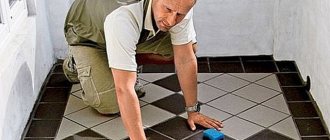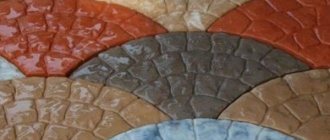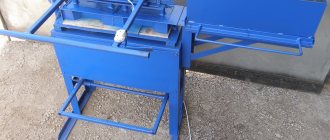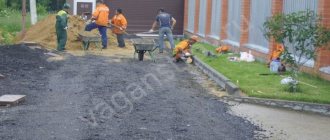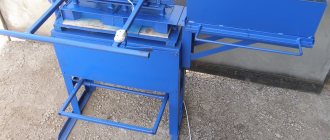Polymer sand tiles are a durable, wear-resistant, aesthetic material for finishing recreation areas, local areas, parking lots, and roads. Products are manufactured using vibration casting, vibration pressing, and heat treatment. The blocks are laid on concrete, sand cushion or crushed stone.
Characteristics, composition and manufacture
technological scheme for the production of polymer sand tiles
Paving slabs, made from polymer materials, are designed for the design of sidewalks, areas near commercial and social facilities, residential buildings, for the creation of parking lots, blind areas, and children's playgrounds. Polymers give composite raw materials density, wear resistance, ductility, and high aesthetic characteristics.
The slabs are made from sand with fractions of no more than 3 mm, crushed polymers of primary or secondary processing, and inorganic dyes. The sand is cleaned, calcined, mixed with components and processed in special equipment. The work uses a press, extruder or concrete mixer. After pressing and heat treatment, the material becomes moisture resistant and has low abrasion.
The material can withstand temperatures down to -70°C. Polymer sand blocks are durable, resistant to chemical compounds, gasoline and machine oils. The blocks are lightweight and come in different shades, configurations, and textures. No dust appears during operation of the stoves. The products are easy to care for and are resistant to changes in temperature conditions.
Comparative characteristics of polymer sand and concrete tiles
Slabs made of concrete and polymer compounds are used for laying sidewalks and adjacent areas. Products made from concrete composition are inexpensive, easy to manufacture, but short-lived, easily damaged, and produce dust. Polymer sand paving slabs are more comfortable to use. The products are plastic, water-resistant, have a long shelf life, and are environmentally friendly.
Water absorption characteristics for polymer slabs are no more than 0.15%, for concrete blocks - 4-6.5%. Frost resistance of polymer sand products reaches 500 cycles, concrete - 200-400. The abrasion of polymer-sand tiles is 0.05-0.1 g/cm², and that of concrete tiles is 0.3-0.7 g/cm².
The bending strength of polymer products is 25-35 MPa, concrete - 0.5-6.0(7.0) MPa. The average density of polymer sand products is 1650-1800 kg/m³, concrete - 2200-2400 kg/m³.
In terms of environmental friendliness, concrete blocks are inferior to polymer ones.
At a temperature of +45°C, concrete emits harmful fumes. Melting polymer sand products requires heating the material in special equipment to +120°C.
Raw materials for polymer products are more environmentally friendly (sand, dyes). Concrete blocks require quarrying, transporting gravel, and a complex manufacturing process.
Comparative table of characteristics of polymer sand and concrete tiles
Process of receiving products
The raw materials for the manufacture of finished tiles are publicly available and inexpensive components. You can get them in every region of the country.
- purified sand,
- polymers,
- pigments.
To reduce the cost of purchasing all the necessary components, you can purchase secondary raw materials - they are much cheaper.
As for the exact recipe, everything is strictly individual - each manufacturer works with its own composition. You can develop the recipe yourself, or you can invite an experienced technologist for consultation.
Stages of material production
When producing polymer paving slabs, the following sequence of technological process actions is required:
- It is necessary to grind the polymer raw material or agglomerate it. When using polymer chips, this step is skipped.
- Purified sand, crushed polymers, pigments, and additives are mixed.
- The composition is subjected to heat treatment and melting at +250°C.
- The dissolved cement-sand mixture is transferred to a press and blocks are formed according to standard sizes.
- The products are sorted, packaged, and delivered to shopping centers.
Automated technology is used in the production of slabs. Compliance with standards allows us to produce slabs of the required shape without cracks, chips, or voids.
Composition of the mixture from which the tiles are made
The mixture for the production of polymer sand slabs contains:
- 65-75% purified (washed, sifted) medium-grained sand;
- 25-35% polymer components;
- 3-5% coloring pigments;
- 1-2% stabilizers for UV protection.
Equipment
The production of paving slabs can be carried out in one of two ways - vibration casting or vibration pressing. Both options require the use of specialized equipment. For production using the vibration casting method, you will need a vibrating table, the cost of which is approximately $4,000, you also need molds costing $1-18 apiece, as well as a concrete mixer costing about $800. The vibratory compaction method will require you to have other equipment: a vibrating press, which costs about $20,000, a concrete mixer costing $5,000-6,000, and a punch – $3,000.
Pigments for painting tiles
Metal oxides are used to tint products:
- chromium oxide allows you to give the slabs a green color of different shades;
- titanium dioxide is necessary to create snow-white paving slabs;
- iron oxide allows you to tint blocks in coral, orange, terracotta, brown colors;
Color palette
Manufacturers
Polymer sand tiles are produced both by foreign and Russian enterprises. Among domestic manufacturing companies, the most popular are Prompolymer, Namus, SibTopProm-14 and Polymerica.
- Prompolymer produces polymer-sand finishing materials, as well as metal structures and packaging. The products of this company have quality certificates and sanitary-epidemiological conclusions.
- "Namus" is a Tatarstan company that produces polymer sand products, slabs, gutters, and so on. The tiles come in grey, green, brown and red shades. The texture of the tile can imitate parquet, brick, or simply be smooth.
- "SibTopProm-14" is a young manufacturing company from Tyumen. Polymer sand tiles from SibTopProm-14 are available in shades similar to Namus.
- "Polymerika" is a Yaroslavl company engaged in the production of tiles and tiles from a polymer-sand mixture. The product meets safety requirements and regularly undergoes various tests.
Specifications
Standard characteristics of polymer sand products may vary depending on the manufacturing method. According to the standards, the density of the blocks reaches 1600-1800 kg/m², the abrasion parameters are 0.05-0.1 g/cm², the volume of water absorption should not exceed 0.15%. The bending and compressive strength of blocks from different companies is 17-25 MPa. Frost resistance of products is at least 300-500 cycles. The shelf life reaches 50 years. The material does not deform at temperatures of -70…+250°C. Blocks can be plain or with a combination of different shades.
What is a production line?
The set of equipment offered by the Ivanovo Mechanical Plant includes the following main units:
- dispenser (provides accurate measurement of prescription components);
- mixer (guarantee of uniform distribution of plastic, sand and pigment throughout the entire volume of the mixture);
- sand dryer;
- melting unit;
- Hydraulic Press;
- molds for various types of products.
The power of the equipment is selected based on the planned production volume.
Laying technology
Laying paving slabs with your own hands is carried out in different ways in accordance with the load and quality of the soil.
The blocks are installed on a layer:
- from sand;
- from sand and crushed stone;
- made of concrete.
Laying of slabs as a floor covering for sidewalks is carried out in a “checkerboard” or “herringbone” pattern. The light weight allows the blocks to be mounted on the roof or supporting elements with a waterproofing layer.
Installation of slabs is carried out in dry weather. the distance between the blocks should be at least 5-7 mm. The surface for the tiles must be level.
Laying technology
On a sand cushion
To lay polymer sand blocks on a sand cushion, it is necessary to remove a layer of soil up to 20-25 cm.
At the initial stage, it is important to calculate the slope of the surface for drainage of wastewater.
The cleared surface is compacted. Ditches are created along the perimeter of the site, and the bottom of the trenches is compacted. Sand is poured into the openings for curbs in a layer of 3-5 cm; after adding water, the sand coating is compacted.
Then work is carried out on marking the garden path. Border lines are marked using a rope or cord that is pulled over pegs or reinforcement.
It is necessary to prepare a cement mortar that is placed on the base. The curb is laid out at the marked level. The bottom of the pit is lined with geotextiles; the sheets must overlap by 10-15 cm. Sand is laid in layers, which are soaked in water and compacted. The height of the sand cushion reaches 15-20 cm. A trench is also being designed to drain water after rain.
After the preparation stage, the slabs are laid out, maintaining a gap of 3-5 mm between the elements, and the blocks are compacted by tapping with a rubber hammer. The seams are filled with sand and sealant.
Another method involves installing an additional reinforcing layer of metal rods, which is necessary for places with high loads and strength requirements. After reinforcement, a cement-sand composition with proportions of 1:3 is added to a height of 5-6 cm. The coating is watered, and slabs are mounted on top.
laying on a sand bed
Mixture of sand and crushed stone
The next method involves the use of sand and crushed stone with fractions of 10-20 mm. The technology makes it possible to increase the strength of the base and the durability of the coating. The crushed stone must be compacted; the thickness of the gravel cushion reaches 10-20 cm. Then the concrete composition (5-10 cm) is poured while maintaining the specified slope.
Main job
This type of manufacturing of paving slabs involves the use of advanced technologies that involve the processing of secondary raw materials, that is, polymer products should be obtained. This process indicates a change not only in the thinking, but also in the attitude towards making a profit for producers.
Thanks to the ongoing global changes, we can talk about the transformation of the resource-based economy into a modern high-tech form, which allows rational use of available resources and does not lead to environmental pollution. Naturally, such production requires considerable financial investments, but they will quickly return after the start of work.
Benefits of use
laid polymer sand slab
The advantages of polymer sand slabs are:
- in wear resistance;
- in durability (30-50 years);
- low water absorption and resistance to sub-zero temperatures;
- high strength and ductility (the material does not crack or deform);
- in convenient transportation;
- in resistance to wear;
- in safe operation;
- in a small mass, ensuring convenient installation, including on interfloor ceilings and part of the roof;
- in low thermal conductivity;
- in anti-slip characteristics;
- in oil resistance and resistance to acidic environments;
- in processing that provides protection against mold and mildew.
- in maintainability;
- in a wide range of sizes, shades;
- in a wide operating temperature range (-60…+45°С).
- resistant to high loads (the blocks can withstand the impact of passenger cars and trucks).
Upcoming expenses
In addition to the cost of equipment, you will have to carefully consider the issue of providing raw materials. A great option to reduce the cost of production is to use recycled plastic. By the way, many regions have targeted programs to encourage socially responsible businesses. The environmental component, which consists in the safe recycling of plastic and rubber waste, can become the basis for receiving various subsidies and other types of assistance.
The expenses include the following items:
- rent of premises, utility bills;
- fare;
- organization of warehousing of raw materials and finished products;
- wages (including social contributions);
- tax payments;
- Unexpected expenses.
Disadvantages of use
laying polymer sand tiles
The disadvantage of polymer sand slabs is their ability to expand under the influence of elevated temperatures. A path paved with a violation of the technological process (gaps between elements is no more than 5 mm) may become deformed in hot summers. Polymer sand blocks are more expensive than their concrete counterparts and require a more complex installation process. The production process is carried out using expensive equipment.
Business registration
In order to start polymer production, it will be quite enough to obtain registration of an individual entrepreneur. Paving slabs belong to a category of products that are not subject to special certification, and this greatly simplifies the entire process of registering a business.
However, if you want to have a document indicating the proper quality of your products, you can order a study from a certification service, where polymer sand tiles will be tested for abrasion, strength, frost resistance and other properties. After this, you will be issued a product quality certificate indicating the main characteristics.
Installation methods: drawing
Rustic curtains.
See the renovation of a room for a teenage girl here.Types of putty for walls: https://trendsdesign.ru/materialy/shpaklevka/osobennosti-shpatlevaniya.html
Customer Reviews
Anton, Chelyabinsk
I used polymer sand tiles in the garage. I put it on glue, everything holds very tightly. Hammers and other heavy objects fell on the tile, but nothing happened to it. I didn't find any cracks or chips. The tiles also withstood the winter remarkably well.
Vasily, Ekaterinburg
On the advice of a friend, I purchased polymer sand tiles to decorate the path. He laid it on the sand. The tile stuck well, but I think all the credit goes to the glue, since I bought a special one. Overall, I'm happy with the tiles, no complaints. All the positive qualities declared by the manufacturer are present.
Arkady, Surgut
They laid the tiles on the sand. It was washed out by the rain, but the tiles are holding tightly. We wash it with water and detergents as it gets dirty. And she is still just as beautiful and pure. We will definitely use it again.

